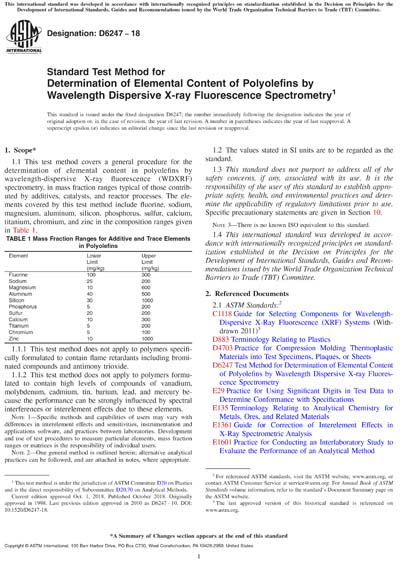Most recent
ASTM D6247-18
Standard Test Method for Determination of Elemental Content of Polyolefins by Wavelength Dispersive X-ray Fluorescence Spectrometry
1.1 This test method covers a general procedure for the determination of elemental content in polyolefins by wavelength-dispersive X-ray fluorescence (WDXRF) spectrometry, in mass fraction ranges typical of those contributed by additives, catalysts, and reactor processes. The elements covered by this test method include fluorine, sodium, magnesium, aluminum, silicon, phosphorus, sulfur, calcium, titanium, chromium, and zinc in the composition ranges given in Table 1.
1.1.1 This test method does not apply to polymers specifically formulated to contain flame retardants including brominated compounds and antimony trioxide.
1.1.2 This test method does not apply to polymers formulated to contain high levels of compounds of vanadium, molybdenum, cadmium, tin, barium, lead, and mercury because the performance can be strongly influenced by spectral interferences or interelement effects due to these elements.
Note 1: Specific methods and capabilities of users may vary with differences in interelement effects and sensitivities, instrumentation and applications software, and practices between laboratories. Development and use of test procedures to measure particular elements, mass fraction ranges or matrices is the responsibility of individual users.
Note 2: One general method is outlined herein; alternative analytical practices can be followed, and are attached in notes, where appropriate.
1.2 The values stated in SI units are to be regarded as the standard.
1.3 This standard does not purport to address all of the safety concerns, if any, associated with its use. It is the responsibility of the user of this standard to establish appropriate safety, health, and environmental practices and determine the applicability of regulatory limitations prior to use. Specific precautionary statements are given in Section 10.
Note 3: There is no known ISO equivalent to this standard.
1.4 This international standard was developed in accordance with internationally recognized principles on standardization established in the Decision on Principles for the Development of International Standards, Guides and Recommendations issued by the World Trade Organization Technical Barriers to Trade (TBT) Committee.
Content Provider
ASTM International [astm]






